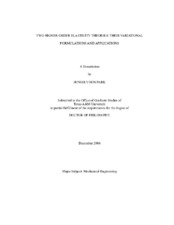| dc.description.abstract | Classical elasticity cannot be used to explain effects related to material
microstructures due to its lack of a material length scale parameter. To mitigate this
deficiency, higher order elasticity theories have been developed. Two simple higher
order theories and their applications are studied in this research. One is a modified
couple stress theory and the other is a simplified strain gradient theory, each of which
contains only one material length scale parameter in addition to the classical elastic
constants. Variational formulations are provided for these two theories by using the
principle of minimum total potential energy. In both cases, the governing equations and
complete boundary conditions are determined simultaneously for the first time. Also, the
displacement form is explicitly derived for each theory for the first time.
The modified couple stress theory is applied to solve a simple shear problem, to
develop a new Bernoulli-Euler beam model, and to derive the constitutive relations for
hexagonal honeycomb structures, while the simplified strain gradient theory is used to
solve the pressurized thick-walled cylinder problem. All these models/solutions are
obtained for the first time and supplement their counterparts in classical elasticity.
Numerical results obtained from the newly developed models and derived solutions
and their comparisons with their counterpart results in classical elasticity reveal that the
higher order theory based models and solutions have the capacity to account for
microstructural effects; their counterparts in classical elasticity do not have the same
capability. Nevertheless, the former are shown to recover the latter if the microstructural
effects are suppressed or ignored. | en |


